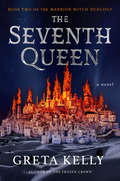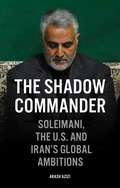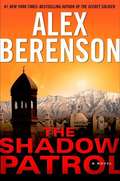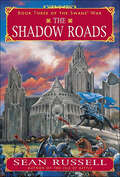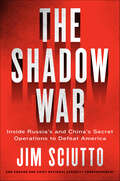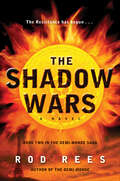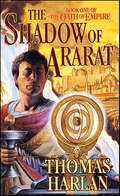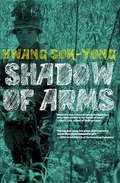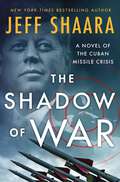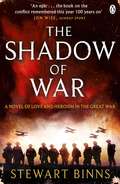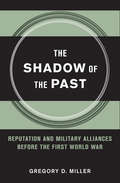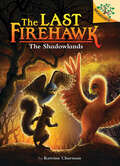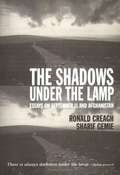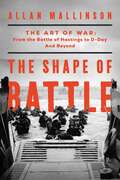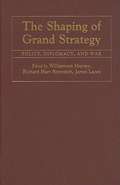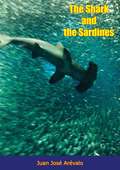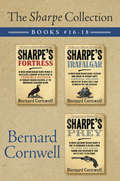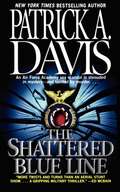- Table View
- List View
The Seventh Queen: A Novel (Warrior Witch Duology #2)
by Greta KellyAfter the gasp-inducing cliffhanger ending of The Frozen Crown, the exciting conclusion to the epic story of Askia—a warrior, witch, and queen-to-be—as she confronts the monster that stole her throne…and is holding her prisoner to steal her magic.The Empire of Vishir has lost its ruler, and the fight to save Seravesh from the Roven Empire is looking bleak. Moreover, Askia has been captured by power-hungry Emperor Radovan, who plans on making her his wife simply so he can take her magic as his own, killing her in the process. Aware of his ex-wives’ fates, Askia must find a means of avoiding this doom, not only for the sake of Seravesh, but now for Vishir as well. She must put both nations first and remember Ozura’s advice: you must play the game in order to survive. Askia was born a soldier, but now it’s time to become a spy. But it’s hard to play a game where the only person who knows the rules wants to kill her. And time is a factor. The jewel Radovan has put around her neck will pull her power from her in thirty days. Worse, Vishir might not even have that long, as the two heirs to the throne are on the verge of civil war. Without any hope for help from the south, without any access to her magic, alone in a hostile land, Askia is no closer to freeing her people than she was when she fled to Vishir. In the clutches of a madman, the only thing she’s close to is death. Yet she’d trade her life for a chance to save Seravesh. The problem: she may not have that choice.
The Seventh Sense: The Secrets of Remote Viewing as Told by a "Psychi
by Lyn BuchananFor the past thirty years, the United States government has secretly trained a select corps of military personnel in the art of "remote viewing" -- the psychic ability to perceive the thoughts and experiences of others through the power of the human mind.... Now, for the first time, Lyn Buchanan -- a world-renowned expert on remote viewing and its potential -- tells the complete, candid story of his experiences. Assigned for nearly a decade to a clandestine U.S. Army intelligence group, Buchanan trained military personnel who utilized their inherent psychic abilities as a data-collection tool during the Iran hostage crisis, the Chernobyl disaster, and the Gulf War. In this incredible account, Buchanan tells how he was selected for his unique psychic abilities, and how he was transformed from an ordinary soldier into one of our nation's leading psychic spies. Working on top-secret government and military projects using "mental espionage" created permanent, life-altering changes within Buchanan. Now, after many years of analysis and interpretation, he reveals the techniques and mental exercises used to train remote viewers, and demonstrates that each of us carries a dormant psychic ability that we can explore and use ourselves. For anyone interested in a hard, scientific look at the reality of psychic covert operations in the world today, or anyone who has ever wondered if he or she could have the inherent skills to become a remote viewer, this fascinating chronicle of life as a psychic spy will reveal the answers.
The Sexual Economy of War: Discipline and Desire in the U.S. Army (Battlegrounds: Cornell Studies in Military History)
by Andrew ByersIn The Sexual Economy of War, Andrew Byers argues that in the early twentieth century, concerns about unregulated sexuality affected every aspect of how the US Army conducted military operations. Far from being an exercise marginal to the institution and its scope of operations, governing sexuality was, in fact, integral to the military experience during a time of two global conflicts and numerous other army deployments.In this revealing study, Byers shows that none of the issues related to current debates about gender, sex, and the military—the inclusion of LGBTQ soldiers, sexual harassment and violence, the integration of women—is new at all. Framing the American story within an international context, he looks at case studies from the continental United States, Hawaii, the Philippines, France, and Germany. Drawing on internal army policy documents, soldiers' personal papers, and disciplinary records used in criminal investigations, The Sexual Economy of War illuminates how the US Army used official policy, legal enforcement, indoctrination, and military culture to govern wayward sexual behaviors. Such regulation, and its active opposition, leads Byers to conclude that the tension between organizational control and individual agency has deep and tangled historical roots.
The Shadow Commander: Soleimani, the US, and Iran's Global Ambitions
by Arash AziziWhen the US assassinated Qassem Soleimani in January 2020, he was one of the most powerful men in Iran. The military spearhead for Iranian foreign policy, he enacted the wishes of the country&’s Supreme Leader, establishing the Islamic Republic as a major force in the Middle East. He masterminded interventions in Afghanistan, Iraq, Lebanon, Syria and Yemen, supporting Iran&’s allies and campaigning against the Taliban, US forces, Israel and ISIS. But all this was a long way from where he began – on the margins of a country whose ruler was regarded as a friend of the West. In this gripping account, Arash Azizi examines Soleimani&’s life, regional influence and future ambitions. He breaks new ground through interviews with Iranians, Afghans, Iraqis and Syrians who knew Soleimani for years, including his personal driver, the aides who accompanied him to his Moscow meeting with Vladimir Putin, and his brother. Through Soleimani, Azizi reveals the true nature of Iran&’s global ambitions, providing a rare insight into a country whose actions are much talked about but seldom understood.
The Shadow King: A Novel
by Maaza MengisteShortlisted for the 2020 Booker Prize, and named a best book of the year by the New York Times, NPR, Elle, Time, and more, The Shadow King is an “unforgettable epic from an immensely talented author who’s unafraid to take risks” (Michael Schaub, NPR).Set during Mussolini’s 1935 invasion of Ethiopia, The Shadow King takes us back to the first real conflict of World War II, casting light on the women soldiers who were left out of the historical record. At its heart is orphaned maid Hirut, who finds herself tumbling into a new world of thefts and violations, of betrayals and overwhelming rage. What follows is a heartrending and unputdownable exploration of what it means to be a woman at war.
The Shadow Patrol (John Wells Series #6)
by Alex BerensonIn 2009, the CIA's Kabul Station fell for a source who promised to lead it to Bin Laden, but instead he blew himself up, taking the station's most senior officers with him. Now, more than two years later, the station is still floundering, agents are dying, and at Langley the CIA's chiefs wonder if the unthinkable has happened, if somehow the Taliban has infiltrated the station. When they ask John Wells to investigate, he reluctantly agrees to return to the country where his career as an undercover operative began. But there, he finds a vipers' nest of hostility and mistrust-and clues that hint at a drug-trafficking operation involving the Agency, the military, and the Taliban. Americans are dying, and an American is responsible. And only John Wells stands in his way . . . for now.
The Shadow Roads: Book Three Of The Swans' War (The Swans' War Series #3)
by Sean RussellSoldiers, sorcerers and feuding families enter the climactic final phase of a brutal civil war in the third novel of this epic fantasy trilogy.Two mighty families have been locked in savage combat, ravaging the kingdom both wish to rule. The chaos and bloodshed have spawned treachery within the ranks of both the Renné and the Wills, drawing the brave, the innocent, and the malevolent alike into the bloody conflict. But a far more terrible consequence has arisen from the carnage—for Death himself has been roused from his dread domain . . . and is preparing to walk the world again.
The Shadow War: Inside Russia's and China's Secret Operations to Defeat America
by Jim SciuttoAre we losing a war few of us realize we’re fighting? Jim Sciutto, CNN’s Chief National Security Correspondent, reveals the invisible fronts that make up 21st century warfare, from disinformation campaigns to advanced satellite weapons.Poisoned dissidents. Election interference. Armed invasions. International treaties thrown into chaos. Secret military buildups. Hackers and viruses. Weapons deployed in space. China and Russia (and Iran and North Korea) spark news stories by carrying out bold acts of aggression and violating international laws and norms. Isn’t this just bad actors acting badly?That kind of thinking is outdated and dangerous. Emboldened by their successes, these countries are, in fact, waging a brazen, global war on the US and the West. This is a new Cold War, which will not be won by those who fail to realize they are fighting it. The enemies of the West understand that while they are unlikely to win a shooting war, they have another path to victory. And what we see as our greatest strengths—open societies, military innovation, dominance of technology on Earth and in space, longstanding leadership in global institutions—these countries are undermining or turning into weaknesses.In The Shadow War,CNN anchor and chief national security correspondent Jim Sciutto provides us with a revealing and at times disturbing guide to this new international conflict. This Shadow War is already the greatest threat to America’s national security, even though most Americans know little or nothing about it. With on-the-ground reporting from Ukraine to the South China Sea, from a sub under the Arctic to unprecedented access to America’s Space Command, Sciutto draws on his deep knowledge, high-level contacts, and personal experience as a journalist and diplomat to paint the most comprehensive and vivid picture of a nation targeted by a new and disturbing brand of warfare.Thankfully, America is adapting and fighting back. In The Shadow War, Sciutto introduces readers to the dizzying array of soldiers, sailors, submariners and their commanders, space engineers, computer scientists, civilians, and senior intelligence officials who are on the front lines of this new kind of forever war. Intensive and disturbing, this invaluable and important work opens our eyes and makes clear that the war of the future is already here.
The Shadow Wars: A Novel (The Demi-Monde Saga)
by Rod ReesRod Rees’s riveting dystopian saga continues with The Shadow Wars, the spellbinding sequel to The Demi-Monde: Winter.First Daughter Norma Williams finds herself stranded in the sinister cyber-world of the not-so-distant future that’s inhabited by some of history’s most menacing villains. Betrayed by those she thought were friends, she must lead the resistance against a terrifying force if she wants to survive.Skillfully written and highly imaginative, The Shadow Wars blends elements of steampunk with science fiction in an adventure that will keep you on the edge of your seat and captivated until the very end.
The Shadow of Ararat: Book One of 'The Oath of Empire' (The Oath of Empire #1)
by Thomas HarlanIn what would be A.D. 600 in our history, the Roman Empire still stands, supported by the Legions and Thaumaturges of Rome. Now the Emperor of the West, the Augustus Galen Atreus, will come to the aid of the Emperor of the East, the Augustus Heraclius, to lift the siege of Constantinople and carry a great war to the very doorstep of the Shahanshah of Persia. It is a war that will be fought with armies both conventional and magical, with bright swords and the darkest necromancy. Against this richly detailed canvas of alternate history and military strategy, Thomas Harlan sets the intricate and moving stories of four people: > Dwyrin MacDonald is a Hibernian student at a school for sorcerers in Upper Egypt, until he runs afoul of powerful political interests and is sent off half-trained to the Legions. > His teacher, Ahmet, undertakes to follow Dwyrin and aid him, but Ahmet is drawn into service with the queen of Palmeyra. > Thyatis is a young female warrior, extensively trained by her patron in the arts of covert warfare. > And Maxian Atreus is Galens youngest brother, a physician and sorcerer. He has discovered that an enemy of Rome has placed a dreadful curse on the City, which must be broken before Rome can triumph. Woven with rich detail youd expect from a first-rate historical novel, while through it runs yarns of magic and shimmering glamours that carry you deeply into your most fantastic dreamsAt the Publisher's request, this title is being sold without Digital Rights Management Software (DRM) applied.
The Shadow of Arms
by Hwang Sok-YongA novel of the black markets of the South Vietnamese city of Da Nang during the Vietnam War, based on the author's experiences as a self-described South Korean mercenary on the side of the South Vietnamese, this is a Vietnam War novel like no other, truly one that sees the war from all sides. Scenes of battle are breathtakingly well told. The plot is thick with intrigue and complex subplots. But ultimately The Shadow of Arms is a novel of the human condition rather than of the exploits and losses of one side or the other in war. From the Trade Paperback edition.
The Shadow of War: A Novel of the Cuban Missile Crisis
by Jeff ShaaraFrom the bestselling author comes the story of rising conflict between the super-powers that gripped the world, a global war that almost happened: The Cuban Missile Crisis.In 1961, the new president John F. Kennedy, inherited an ill-conceived, poorly executed invasion of Cuba that failed miserably and set in motion the events that put the U.S. and the Soviet Union on a collision course that nearly started a war that would have enveloped much of the world. Extensively researched and vividly imagined, The Shadow of War brings to life the many threads that lead to the building crisis between the Soviet Union and the United States in 1962. Told from a multitude of perspectives and voices, from the Russian engineer attempting the near impossible task of building the missile launch facilities in Cuba, to the U.S. Navy commanders who ships are sent to "quarantine" Cuba, to the Soviet Premier, Nikita Khrushchev, desperately trying to maintain a challenging balancing act between the conflicting demands of various powerful forces, to the brothers Kennedy (Bobby and JFK) who can't allow Russia to land nuclear missiles in Cuba, or to appear weak in confronting Khrushchev, but keenly understand how close they are dancing to the edge of war. Shaara brings to life all the action and actors, famous and little known, that embodied a war that almost happened, the Cuban Missile Crisis.
The Shadow of War: The Great War Series Book 1 (The Great War #1)
by Stewart BinnsThe Shadow of War is the first novel in Stewart Binns's new series which will see a book release for each year of the First World War.June 1914. The beginning of another long, prosperous summer for Britain. But beneath the clear skies, all is not as it seem - as the chill wind of social discontent swirls around this sceptred isle. Shots ring out in a distant European land - the assassination of a foreign aristocrat. From that moment the entire world is propelled into a conflict unlike any seen before. This is the story of five British communities, their circumstances very different, but who will all share in the tragedy that is to come. All that they have known will be changed for ever by the catastrophic events of the Great War.This is a story of love and comradeship, of hatred and tragedy - this is the story of the Great War. The Shadow of War, the first novel in The Great War series from Stewart Binns, is a thrilling read and perfect for those who enjoy the writing of Conn Iggulden and Bernard Cornwell. Praise for Stewart Binns: 'Anyone with even a vague interest in Britain and the Great War should read Shadow of War' Celia Sandys, granddaughter of Winston Churchill 'A fascinating mix of fact, legend and fiction . . . this is storytelling at its best' Daily Mail 'Stewart Binns has produced a real page-turner, a truly stunning adventure story' Alastair Campbell 'Once again Stewart Binns has managed to create something unique, entertaining and eye-opening' Parmenion Books 'Unarguably heart-warming... will leave any reader with a sense of British pride' Goodreads 'Truly a book that educates while entertaining, a talent of this best-selling author' Historical Novel Review Stewart Binns began his professional life as an academic. He then pursued several adventures, including a stint at the BBC, before settling into a career as a schoolteacher, specializing in history. Later in life a lucky break took him back to the BBC, which was gthe beginning of a successful career in television. He has won a BAFTA, a Grierson, an RTS and a Peabody for his documentaries. Stewart's passion is English history especially its origins and folklore. His previous Making of England series: Crusade, Conquest, Anarchy and Lionheart, were published to great acclaim
The Shadow of the Past: Reputation and Military Alliances before the First World War (Cornell Studies in Security Affairs)
by Gregory D. MillerIn The Shadow of the Past, Gregory D. Miller examines the role that reputation plays in international politics, emphasizing the importance of reliability—confidence that, based on past political actions, a country will make good on its promises—in the formation of military alliances. Challenging recent scholarship that focuses on the importance of credibility—a state’s reputation for following through on its threats—Miller finds that reliable states have much greater freedom in forming alliances than those that invest resources in building military force but then use it inconsistently. To explore the formation and maintenance of alliances based on reputation, Miller draws on insights from both political science and business theory to track the evolution of great power relations before the First World War. He starts with the British decision to abandon "splendid isolation" in 1900 and examines three crises—the First Moroccan Crisis (1905–6), the Bosnia-Herzegovina Crisis (1908–9), and the Agadir Crisis (1911)—leading up to the war. He determines that states with a reputation for being a reliable ally have an easier time finding other reliable allies, and have greater autonomy within their alliances, than do states with a reputation for unreliability. Further, a history of reliability carries long-term benefits, as states tend not to lose allies even when their reputation declines.
The Shadowlands: A Branches Book (The Last Firehawk #5)
by Katrina CharmanThe Last Firehawk series has young readers on the edge of their seats!Pick a book. Grow a Reader!This series is part of Scholastic's early chapter book line, Branches, aimed at newly independent readers. With easy-to-read text, high-interest content, fast-paced plots, and illustrations on every page, these books will boost reading confidence and stamina. Branches books help readers grow!In book 5 of this fantasy series, the magical Ember Stone is almost complete! There is only one piece left to find. But Thorn's darkness is spreading faster than ever! Tag, Skyla, and Blaze must cross the dangerous Shadowlands to find the last piece. What-or who-will they meet along the way? Can the friends complete the stone in time to save Perodia? Engaging black-and-white illustrations on every page bring the action alive in this fast-paced early chapter book series!
The Shadows Under the Lamp: Essays on September 11 and Afghanistan
by Ronald Creagh Sharif GemieThis book discusses the history and culture of Afghanistan in the context of the post-September 11 world.
The Shape of Battle: The Art of War from the Battle of Hastings to D-Day and Beyond
by Allan MallinsonA distinguished military historian tells the dramatic story of six defining battles in world history.Every battle is different. Each takes place in a different context—the war, the campaign, the weapons. However, battles across the centuries, whether fought with spears and swords or advanced technology, have much in common. Fighting is, after all, an intensely human affair; human nature doesn't change. So why were certain battles fought as they were? What gave them their shape? Why did they go as they did: victory for one side, defeat for the other? In exploring six significant feats of arms—the war and campaign in which they each occurred, and the factors that determined their precise form and course—The Shape of Battle answers these fundamental questions about the waging of war. Eschewing polemics, The Shape of Battle doesn't try to argue a case. It lets the narratives—the battles—speak for themselves.
The Shaping of Grand Strategy: Policy, Diplomacy, and War
by Williamson Murray James Lacey Richard Hart SinnreichWithin a variety of historical contexts, The Shaping of Grand Strategy addresses the most important tasks states have confronted: namely, how to protect their citizens against the short-range as well as long-range dangers their polities confront in the present and may confront in the future. To be successful, grand strategy demands that governments and leaders chart a course that involves more than simply reacting to immediate events. Above all, it demands they adapt to sudden and major changes in the international environment, which more often than not involves the outbreak of great conflicts but at times demands recognition of major economic, political, or diplomatic changes. This collection of essays explores the successes as well as failures of great states attempting to create grand strategies that work and aims at achieving an understanding of some of the extraordinary difficulties involved in casting, evolving and adapting grand strategy to the realities of the world.
The Shark and the Sardines
by Juan José Arévalo June CobbThe Shark and the Sardines is a scathing allegorical short story by Juan José Arévalo Bermejo (1904-1990), who was the first of the reformist presidents of Guatemala (1944-1951). As a country that had seen a series of dictatorships following its independence from Spain, Arévalo’s 1944 election is considered by historians to be the first fair and democratic election in Guatemala’s republican history.Arévalo’s administration was marked by unprecedented relatively free political life during his six-year term. An educator and philosopher, he understood the need for advancement in individuals, communities, and nations by practical means.“It appears to be a truism today that anything touching upon US-Latin American policy is bound to end either in histrionics or hysteria, whether of the Left or Right. And former president of Guatemala, Juan Jose Arevalo’s The Shark and the Sardines is no exception. Free flowing, full of rhetoric at once both surly and suave, astream with shockers, statistics and stilettos, it promulgates what the blurbs dubb a “poetically tragic fable”, depicting in iridescent black and white the tortured heart beating south of our border, wherein Uncle Sam emerges as the Shark and the mestiza have-nots, the poor Sardines.”—KIRKUS Review
The Sharpe Collection: Books #12-15
by Bernard CornwellThe Sharpe Collection: Books #12-15: Sharpe's Devil, Sharpe's Battle, Sharpe's Tiger, and Sharpe's Triumph
The Sharpe Collection: Books #16-18
by Bernard CornwellThe Sharpe Collection: Books #16-18: Sharpe's Fortress, Sharpe's Trafalgar, and Sharpe's Prey
The Shattered Blue Line
by Patrick A. DavisINSIDE AN AIR FORCE ACADEMY SEX SCANDAL INVESTIGATION, ANOTHER HEINOUS CRIME COMES TO LIGHT: MURDER. Major Nathan Malone figured his DWI charge was about to get him fired from the Office of Special Investigations. Instead, he's pulled from his holding cell to take on a shocking case: during an ongoing Congressional investigation into a sex scandal at the U.S. Air Force Academy, two female cadets are found brutally murdered. Accustomed to living on the edge, and used to his chiseled looks opening doors, Malone finds his devil-may-care attitude is shaken to the core as he and his partner, the uncompromising Marva "Mother" Hubbard, track a sadistic killer intent on keeping the secrets of the past buried deep.
The Shattered Lens: A War Photographer's True Story of Captivity and Survival in Syria
by Jonathan Alpeyrie Stash LuczkiwDiscover a gripping and harrowing tale of war and torture from the man who lived it in this powerful memoir by the celebrated war journalist who not only documented over a dozen conflict zones worldwide but was also captured and held hostage by Syrian rebels in 2013.Capturing history was Jonathan Alpeyrie’s job but he never expected to become a news story himself. For a decade, the French‑American photojournalist had weaved in and out of over a dozen conflict zones. He photographed civilians being chased out of their homes, military trucks roving over bullet‑torn battlefields, and too many bodies to count. But on April 29, 2013, during his third assignment to Syria, Alpeyrie was betrayed by his fixer and handed over to a band of Syrian rebels. For eighty‑one days he was bound, blindfolded, and beaten. Not too far away, President Bashar al‑Assad’s forces and those in opposition continued their bitter and bloody civil war. Over the course of his captivity, Alpeyrie kept his spirits up and strived to see, without his camera lenses, the humanity in his captors. He took part in their activities, taught them how to swim, prayed with them, and tried learning their language and culture. He also discovered a dormant faith within himself, one that strengthened him throughout the ordeal. The Shattered Lens is the firsthand account of a photojournalist who has always answered the next adrenaline‑pumping assignment. Yet, during his headline‑making kidnapping, he was left to consider the value and risks of his career, ponder the violent conflicts he had seen, and put the historical events over which we have no control into perspective.
The Shattered Skies (The Cruel Stars Trilogy #2)
by John BirminghamHumanity&’s last surviving heroes must protect a shattered civilization from an all-conquering enemy in this thrilling sequel to The Cruel Stars.The Sturm, an empire of &“species purists,&” have returned from the farthest reaches of Dark Space to wage a war against what they call mutants and borgs: any human being with genetic or neural engineering. In a sneak attack, they overwhelmed almost all of humanity&’s defenses, blasting vicious malware across galaxy-spanning networks, dark code that transformed anyone connected to the system into a mindless psychotic killer. The Sturm&’s victory seemed complete, their final triumph inevitable, until one small band of intrepid, unlikely heroes struck back.Commander Lucinda Hardy and Admiral Frazer McLennan used the Armadalen Navy&’s final surviving warship to fend off the Sturm, destroying the massed power of an entire Attack Fleet. With brilliant tactics—and support from drunken, grief-ravaged pirate Sephina L&’trel and treasonous battle-rig operator Booker—this ragtag crew sent the Sturm running, managing to save Princess Alessia, the sole surviving heir to the gigantic Montanblanc ul Haq Corporation and perhaps Earth&’s only remaining senator.Now left with the remains of a fallen civilization, they must work together to rebuild what was lost and root out the numberless enemies of Earth. The Sturm invaders remain vastly more powerful—and they may not be the only threat lurking in the darkness of space.
The Shattering (Guardians of Ga'Hoole #5)
by Kathryn LaskyIn the Guardians of Ga'Hoole Series Book 5, Eglantine unwittingly becomes a spy for Kludd, leader of the Pure Ones. She is brainwashed by an owl to infiltrate the Great Ga'Hoole Tree. Soren and his friends successfully reverse her odd behavior and brainwashing.
